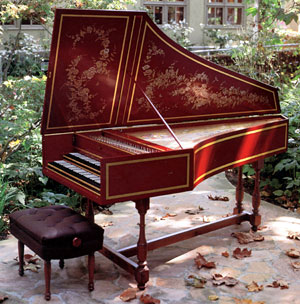Rembrandt Chamber Players offer the Neo as well as the Baroque

Sunday night’s program by the Rembrandt Chamber Players at Evanston’s SPACE was titled “Classic vs. Contemporary.” There was a clear winner at the end of the concert, but the victory was paradoxical – the contemporary pieces being rather more Classical than the classics.
In a reversal of the printed program, the first piece performed was contemporary and a Chicago premiere: American composer Thomas Pasatieri’s Concerto for harpsichord, string quartet, flute and oboe.
In many ways this was the most interesting work of the evening. A retrograde pastiche, the work employs Baroque instrumentation and a mid-twentieth century French expressionism. It might have been written by Poulenc or Françaix for Wanda Landowska – but it was actually premiered in New York in 2009.
Four movements of classical formalism, complete with elaborate solo harpsichord cadenzas (brought off to perfection by the amazing David Schrader) succeeded one another in alert, bubbly performance. The Rembrandt Players have a way with this ornately textured postmodern material and they gave it their all, making a valid case for Pasatieri’s work.
After this faux Baroque, there followed the real thing – and it somehow emerged as less authentic than the imitation.
Telemann’s familiar Suite in A minor for flute and strings was given a straightforward performance with a consistently strong solo by Sandra Morgan. The piece is so well known in commercial recordings, usually with larger forces, that the Rembrandt Players had strong competition to beat with their highly exposed minimalist chamber version.
The same scenario was repeated for the second half of the program with a classically scored contemporary piece preceding a Baroque standard, in this case the Bach Violin (or keyboard) Concerto in A Minor. And again, the contemporary piece outshone the classic, in part through not being overly familiar.
Joan Tower’s Island Prelude, originally written for oboe and string orchestra was heard here in a sonically sufficient arrangement for oboe and string quartet. The work offers ten minutes of lush landscaping— the oboe floats over the lower strings in three sections with a contrasting aggressive middle sandwiched between slower flowing and rather somber outer parts. The composer herself has said the work was inspired by Samuel Barber’s “wonderfully controlled” Adagio for Strings.
The wonderfully controlled oboist was Robert Morgan, who has had a twenty-year relationship with the piece, and the Rembrandt performance was satisfying and evocative.
The concise evening was brought to a close with a run-through of Bach’s oft-heard and always enjoyable Violin Concerto which was played with vigor by Robert Handford and the chamber ensemble.
The program will be repeated 7:30 p.m. Monday in the Driehaus Museum, 40 E. Erie. rembrandtchamberplayers.org; 312-360-3145.
Posted in Performances




